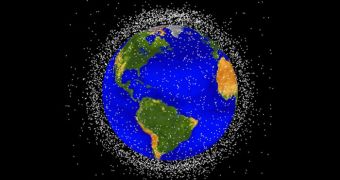As the Space Age began, the Soviet Union and the United States started a space race that saw numerous rockets, satellites and astronauts being sent to orbit. Later, when other countries joined, activity levels increased until finally the amount of junk they put in orbit while doing so posed tremendous risks.
According to the results of a new report on the threat of space junk, tiny and small bits of debris are the most dangerous sort to hit an outgoing rocket, space probe or manned spacecraft. This is the opinion of Sigrid Close, a professor of astronautics at the Stanford University.
As if to make matters worse, we are not the only ones who are clogging the orbit. There are also other classes of naturally-occurring materials that do the same. Collectively called meteoroids, they are equally dangerous, or perhaps even more so, than the larger man-made debris out there.
Statistics compiled by several space agencies indicate that the incidence of collisions between spacecraft and meteoroids is higher than that between spacecraft and man-made debris. However, this difference is constantly getting smaller as more and more junk is produced in space.
In the United States, the responsibility for detecting and tracking human-made objects and debris falls on the US Air Force (USAF), which uses powerful radars to carry out this task.
Data posted on the USAF website indicate that around 22,000 pieces of space debris larger than 10 centimeters zip around Earth at speeds around 7 kilometers per second. However, this figure does not account for the vast amount of smaller objects that cannot be readily tracked via radar.
Close authored the meteoroid section of the report alongside University of Western Ontario (UWO) professor of astronomy Peter Brown. The experts say that several billion such particles orbit the Earth, damaging spacecraft at a rate of one per year.
“One of the issues we raised was that everyone is focused on the impacts of the larger particles and nobody is looking at the mechanism for electrical failures and anomalies associated with small, fast particles, even though it appears as though this is how satellites are failing,” Close explains.
“This would occur from very fast-moving particles and could happen from particles as small as a nanogram. Why are spacecraft having anomalies during high-speed meteor showers?” she adds.
Lately, increasing numbers of experts have begun warning space agencies and governments about the risks associated with increasing amounts of space debris and meteoroid particles around Earth.
Some have even begun investigating methods of getting rid of the larger pieces, which are dangerous because they can collide with each other and be disintegrated into millions of tiny pieces. At this point however, there are only few proposals on how to deal with the smaller particles.

 14 DAY TRIAL //
14 DAY TRIAL //